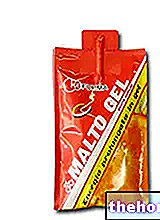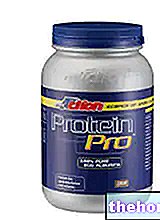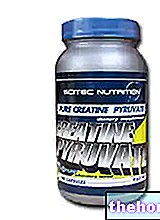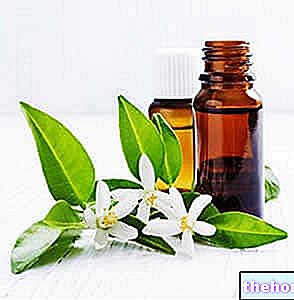
About NAC, Now Foods - N Acetyl Cysteine
Food supplement based on N Acetyl Cysteine
FORMAT
Bottle of 100 cps
COMPOSITION
NAC
Molybdenum (amino acid chelate)
Selenium (selenomethionine)
Capsule: gelatin
Stearic acid and citric acid
One capsule contains: NAC 600 mg
Molybdenum 50 mcg
Selenium 25 mcg
N-Acetyl Cysteine 200mg - it is part, together with glutamate and glycine, in the synthesis of the most powerful antioxidant at our disposal: glutathione. The low bioavailability of dietary cysteine makes this amino acid the limiting factor in the synthesis of glutathione, as well as the oral integration of this tripeptide, which is prematurely degraded and inactivated, is ineffective. The "N acetyl cysteine, on the other hand, can be effectively absorbed in the" intestine and made available at the cellular level, where after deacetylation it regenerates cysteine.
Already in itself, NAC takes on antioxidant properties, but the demonstrated ability to increase endogenous levels of glutathione makes this supplement one of the most efficient fighters of oxidative damage. In fact, numerous therapeutic applications have been tested, aimed at reducing the oxidative insult generated in pathologies such as neurodegenerative and tumor diseases, as well as the anti-influenza and mucolytic properties, which make it one of the best-selling drugs (see fluimucil ®)
Like other antioxidants, it has also proved effective in counteracting the action of ROS following intense physical activity, preserving cellular structures and enhancing the organic pull of endogenous antioxidants.

Molybdenum 50mcg - Trace element present in both animals and plants. Inside the human organism it is a cofactor in various enzymatic reactions involved in the metabolism of sulfur amino acids (methionine and cysteine), in the degradation of nucleotides to uric acid and in the hepatic detoxification processes from drugs and toxins. Present mainly in meats, legumes and whole grains, it is absorbed in the intestine and made available as a cofactor.
The recommended intake levels range between 50 and 150 mcg per day, but very rare are cases of molybdenum deficiency (concentrated in individuals with affections of the gastrointestinal tract).
Dosages higher than 10/15 mg per day have proved dangerous for the onset of gout, while a case of psychosis, hallucinations, and behavioral disturbances is documented following the daily intake of 300 / 800mcg.
Molybdenum supplementation, however, has been shown to be useful in preventing esophageal and gastric cancer and dental caries, at doses comparable to the normal daily requirement.
Furthermore, several studies underline the potential antioxidant capabilities of this trace element.

Selenium 25mcg: it is very present in nature, in Brazilian nuts, in fish, in meats and in some vegetables such as broccoli. It is easily absorbed in the intestine and incorporated by the cells, where it reenters as a coenzyme of the selenium proteins. The form present in this supplement, selenomethionine, is among the most bioavailable, recording absorption levels of 90% of the ingested dose.
As a cofactor it is part of numerous compounds, for example by regulating the metabolism of thyroid hormones (it acts together with deiodinase, generating the active form of the thyroid hormone (T3)), but above all it is part of the protective mechanisms of oxidative damage (glutathione peroxidase and thyroodoxin reductase).
The various isoforms of glutathione peroxidase, in fact, require selenium to perform their antioxidant function, thus being able to neutralize the damage induced by reactive oxygen species. and in countering the onset of cancer, through various mechanisms, not yet fully understood, but at the base of which there is certainly the powerful antioxidant role. Furthermore, a potential role in the prevention of hepatopathies and cardiovascular diseases is also being ascertained.
The need for this element is found to be between 50/70 mcg per day, a value that can be reached through a healthy diet. Deficiencies are very rare, however associated with severe malnutrition, parenteral nutrition and diseases of the gastrointestinal tract.
The maximum dose currently defined as safe, due to the absence of side effects, is about 400 mcg / day. At higher doses, gastrointestinal disorders, fatigue, skin rash and problems affecting the nervous system occur.
In sports, the integration of selenium between 100 and 400mcg per day has been shown to be effective in several studies in reducing the markers of oxidative damage following physical exercise.
Product features NAC, Now Foods - N Acetyl Cysteine
The product under consideration combines two important trace elements with N acetyl cysteine, which is the main active ingredient. Very interesting, in fact, is the presence of selenium, which together with glutathione creates glutathione peroxidase, scavenger of ROS, thus providing another useful element to assist the functionality of this powerful antioxidant.
In the same perspective of prevention of oxidative damage, molybdenum is also added, although unlike the first two substances there are still no studies showing the effectiveness of this element in reducing oxidative damage following intense physical activity.
Method of use recommended by the company - NAC, Now Foods - N Acetyl Cysteine
1 capsule per day during meals
Directions for use in sports NAC, Now Foods - N Acetyl Cysteine
Various studies have tested the effectiveness of supplementation with NAC in sports practice.
The dosages found in these studies start at 600 mg / day and reach 1.2 / 1.8 g / day on training days. In the same, the timing of administration varies from 2 weeks to 6 weeks.
Selenium, on the other hand, is generally used in doses of 100 mcg per day, able - together with other antioxidants - to counteract oxidative damage.
Rationale for use - NAC, Now Foods - N Acetyl Cysteine
This type of supplement has only one use, justified and supported by scientific studies in sports, that of ANTIOXIDANT.
Physical activity, especially if exercised in aerobic conditions, represents an important source of reactive oxygen species, which in excess can on the one hand have a deleterious effect during physical performance (fatigue) and on the other oxidize cellular structures, reducing recovery capacity. Under normal conditions our body is able to counteract this effect, but studies have shown how supplementation with antioxidant agents can support the body in this phase, reducing oxidative markers and enhancing endogenous protective capacities.
Side Effects NAC, Now Foods - N Acetyl Cysteine
There were no particular side effects of oral supplementation with NAC even for prolonged periods.
However, close medical supervision is necessary in the case of asthmatic individuals, with respiratory tract diseases or with gastrointestinal tract diseases.
Intake of the product may occasionally be followed by nausea, vomiting or hypersensitivity reactions such as urticaria and bronchospasm.
Important side effects are recorded for molybdenum in high doses (10 / 15mg), while for selenium dosages around 400mcg / day have been defined as safe.
Interactions
it can interfere with antibiotics of various kinds, if taken at the same time.
This article, elaborated on the critical rereading of scientific articles, university texts and common practice, is for information purposes only and therefore has no medical prescription value. It is therefore always required to consult your doctor, nutritionist or pharmacist before undertaking the use of any supplement.. Learn more about the critical analysis of NAC, Now Foods - N Acetyl Cysteine.
Effects of endurance training on skeletal muscle oxidative capacities with and without selenium supplementation.
Margaritis I, Tessier F, Prou E, Marconnet P, Marini JF.
J Trace Elem Med Biol. 1997 Apr; 11: 37-43.
Exercise-induced oxidant stress in the lung tissue: role of dietary supplementation of vitamin E and selenium.
Veera Reddy K, Charles Kumar T, Prasad M, Reddanna P.
Biochem Int. 1992 Apr; 26: 863-71.
Clin Chim Acta. 2004 Jul; 345 (1-2): 93-8.
Effect of sodium molybdate on the status of lipids, lipid peroxidation and antioxidant systems in alloxan-induced diabetic rats.Panneerselvam SR, Govindasamy S.
Mol Cell Biochem. 1999 Jun; 196 (1-2): 31-42.
Sen CK.
Environmental Energies Technologies Division, University of California at Berkeley, 94720, USA.
Lipoic acid and N-acetyl cysteine decrease mitochondrial-related oxidative stress in Alzheimer disease patient fibroblasts.
Moreira PI, Harris PL, Zhu X, Santos MS, Oliveira CR, Smith MA, Perry G.
J Alzheimers Dis. 2007 Sep; 12: 195-206. Review.
The comparison of antioxidant and hematological properties of N-acetylcysteine and alpha-lipoic acid in physically active males.
Zembron-Lacny A, Slowinska-Lisowska M, Szygula Z, Witkowski K, Szyszka K.
Physiol Res. 2009; 58: 855-61. Epub 2008 Dec 17.
Am Fam Physician. 2009 Aug 1; 80: 265-9.
N-acetylcysteine: multiple clinical applications.
Millea PJ.
Lipoic acid and N-acetyl cysteine decrease mitochondrial-related oxidative stress in Alzheimer disease patient fibroblasts.
Moreira PI, Harris PL, Zhu X, Santos MS, Oliveira CR, Smith MA, Perry G
eid MB, Stokic DS, Koch SM, et al. N-Acetylcysteine inhibits muscle fatigue in humans. J Clin Invest. 1994; 94: 2468-2474Matuszczak Y, Farid M, Jones J, et al. Effect of n-acetylcysteine on glutathione oxidation and fatigue during handgrip exercise. Muscle Nerve. 2005; 32: 633-638. doi: 10.1002 / mus.20385.
The antioxidant role of glutathione and N-acetyl-cysteine supplements and exercise-induced oxidative stress.
Kerksick C, Willoughby D.
J Int Soc Sports Nutr. 2005 Dec 9; 2: 38-44.
Modulatory effect of N-acetylcysteine on pro-antioxidant status and haematological response in healthy men.
Zembron-Lacny A, Slowinska-Lisowska M, Szygula Z, Witkowski Z, Szyszka K.
J Physiol Biochem. 2010 Mar 31. [Epub ahead of print]
Effects of sulfur-containing compounds on plasma redox status in muscle-damaging exercise.
Zembron-Lacny A, Ostapiuk J, Szyszka K.
Chin J Physiol. 2009 Oct 31; 52: 289-94. Erratum in: Chin J Physiol. 2009 Dec 31; 52: 455.
Chest. 2009 Aug; 136: 381-6. Epub 2009 May 15.
Stav D, Raz M.
http://www.pharmamedix.com/principiovoce.php?pa=Acetilcisteina&vo=Warnings
Sulfur in human nutrition and applications in medicine.
Parcell S.
Altern Med Rev. 2002 Feb; 7: 22-44. Review.
Lipids Health Dis. 2010 Mar 6; 9: 23.
Comparative antilipidemic effect of N-acetylcysteine and sesame oil administration in diet-induced hypercholesterolemic mice.Korou LM, Agrogiannis G, Pantopoulou A, Vlachos IS, Iliopoulos D, Karatzas T, Perrea DN.
Neuroprotective effect of N-acetylcysteine in the development of diabetic encephalopathy in streptozotocin-induced diabetes.
Kamboj SS, Chopra K, Sandhir R.
Metab Brain Dis. 2008 Dec; 23: 427-43. Epub 2008 Sep 19.
















.jpg)











